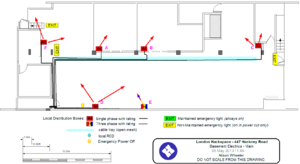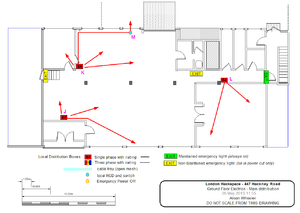447 Power: Difference between revisions
(energy monitoring info) |
|||
| Line 54: | Line 54: | ||
* [http://www.docstoc.com/docs/94607181/IEC-62056-21 reference] | * [http://www.docstoc.com/docs/94607181/IEC-62056-21 reference] | ||
* [https://github.com/bsdphk/PyDLMS/blob/master/dlms.py possible starting point] | * [https://github.com/bsdphk/PyDLMS/blob/master/dlms.py possible starting point] | ||
We also have an open energy monitor (thanks to [[User:Russ]]), the bits we've got are: | |||
* 1 x [http://openenergymonitor.org/emon/emontx emonTx] | |||
* 3 x [http://shop.openenergymonitor.com/100a-max-clip-on-current-sensor-ct/ SCT013 current clamps] | |||
* 1 x [http://wiki.openenergymonitor.org/index.php?title=RFM12Pi_V2 RFM12Pi] | |||
* 1 x [http://openenergymonitor.org/emon/emonbase/raspberrypi RaspberryPi] | |||
* 1 x HDMI <-> VGA thing, (Thanks to [[User:Jonty]]), [http://www.amazon.co.uk/Cable-Matters-Active-Female-Adapter/dp/B00879DM56/ref=cm_cr_pr_product_top possibly this one] | |||
[[Category:Premises]] | [[Category:Premises]] | ||
[[Category:Infrastructure]] | [[Category:Infrastructure]] | ||
Revision as of 19:36, 17 September 2013
There are two sets of circuits now in use: the 'old' ones already installed when we arrived, and the 'new' ones which we have added. The former are all supplied via old-fashioned fuses installed in a fusebox in the (locked) power intake room and, except for the kitchen, do not have additional (ie RCD) protection. Because of this lack we plan to stop using these circuits, with the exception of the ceiling lighting circuits.
The new circuits are connected through local distribution boards ('Consumer Units') via a new main board, all using circuit breakers (MCBs) with RCD protection on most circuits. The status of all of the breakers can be seen without opening the units. Each local distribution board will supply power to a given allocated area, which can be seen on the plans below.
Phase allocation
- We have a three-phase supply and need to keep our consumption on each phase roughly equal.
- This means that different areas, even if adjacent, may be on different phases. Do NOT use extension leads from one area to feed equipment in another.
- Remember - NEVER CROSS THE STREAMS! ... er ... PHASES!
Cable Colour Codes
Once upon a time the colour codes in the UK were black neutral, green earth, red live - phase 1, yellow and blue other two live phases when using a 3-phase supply.
Then along came "European Harmonization" and everything changed. In your home "red-black-green" became "brown-blue-green/yellow" and it wasn't too bad. But in the three-phase world the primary (and easily identifiable) red-yellow-blue+black+green became "brown-grey-black+blue+green/yellow", which except for the striped earth don't look much different in the semi-dark. And yes, black was now a *live* wire, not neutral.
And yea, electricians up and down the land of the Angles got most distraught. Especially when they were laying steel-wire-armoured (swa) cables.
At the London Hackspace we have a mix of old and new cables, used for a mix of purposes, because we try to reuse everything to reduce expenditure. This means that you must always check what a wire is being used for and NOT trust the original colour.
- Where the original colours are red-yellow-blue and it is now carrying single phase then red=live, blue=neutral, yellow=earth
- Where the original colours are brown-black-grey and it is now carrying single phase then brown=live, black=neutral, grey=earth
- Tape will usually be used at each end of the cable to correctly identify the use. These colourways are not necessarily a 'standard' but are easiest to work out as live and neutral always follow one old code and one new code, with the most obvious red/brown being live, and blue/black as neutral.
Basement
Existing lighting remains in situ, along with some wall sockets (mostly at main stairs end). New circuits are provisioned via new distribution boxes as follows:
- Box A: All power, except overhead lighting circuits, which is used in the wood workshop.
- Box B: All power, except overhead lighting circuits, which is used in the 'dirty metal' workshop.
- Box C: All power, except overhead lighting circuits, which is used in the biolab and wet room Grey/Yellow/Phase 3
- Box D: Power circuits, except overhead lighting, for equipment in open workshop area.
- Box E: possible 3-phase 16A power circuit. Not in current use,
- Box F: Power for server stack, future CNC workshop, and additional circuits. Grey/Yellow/Phase 3
Ground Floor
This will be similar to downstairs in terms of getting the power to needed areas, though there are more socket points already in situ; New local distribution boxes are as follows:
- Box J: Supplies sockets in electronics desks, entrance, social space and (part of) central area. Also supplies emergency exit lighting above stairs and at main entrance.Brown/Red/Phase 1
- Box K: Supplies sockets and equipment in local area and circuit to sub-box M supplying outside. Black/Blue/Phase 2
- Box L: Supplies the two socket rings in the new classroom, plus corridor. Also supplies the emergency exit lighting at each end of corridor. Grey/Yellow/Phase 3
- Existing: mostly Brown/Red/Phase 1
- Note: the sockets in the hallway (high up on left, and by doorbot), have an inline fuse located just under the exterior light switch in the adjacent room.
Queries
If you have any queries or want special provision for something, talk to User:Padski.
Works list
- See Power works list
Metering
The power meter is one of these: EDMI Mk10D
We also have an open energy monitor (thanks to User:Russ), the bits we've got are:
- 1 x emonTx
- 3 x SCT013 current clamps
- 1 x RFM12Pi
- 1 x RaspberryPi
- 1 x HDMI <-> VGA thing, (Thanks to User:Jonty), possibly this one

